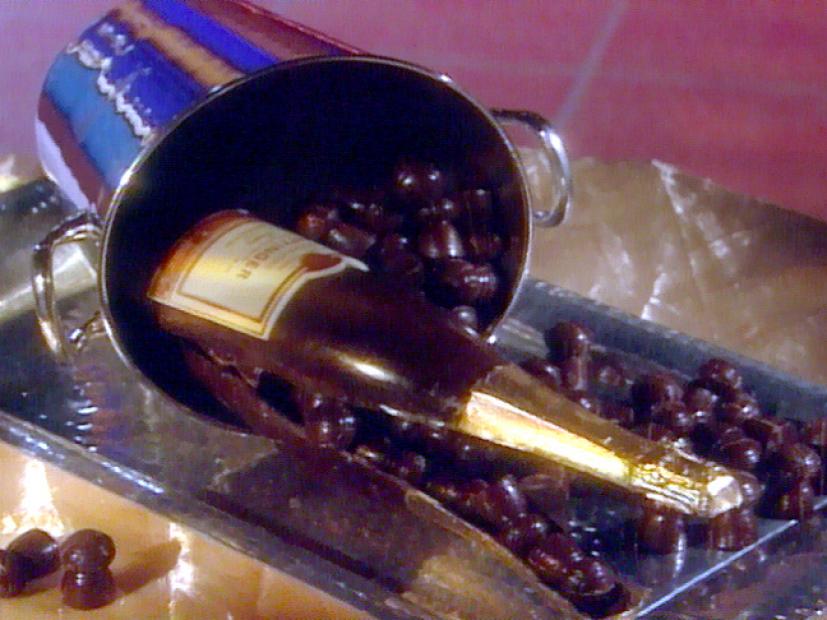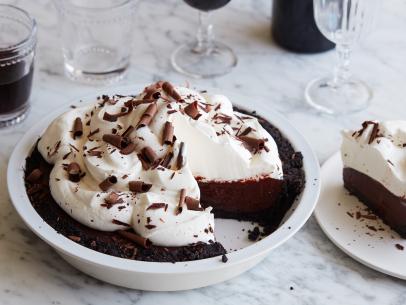
Recipe courtesy of Jacques Torres
Gelatin Molded Champagne Bottle
Getting reviews...
- Level: Advanced
- Total: 2 hr
- Prep: 2 hr
- Yield: 1 champagne bottle
- Level: Advanced
- Total: 2 hr
- Prep: 2 hr
- Yield: 1 champagne bottle
Ingredients
Bottle Mold and Chocolate Bottle:
Decorated Label and Gold Top:
Directions
Special equipment:
see source link for information: Silkscreen kit Aluminum flashing Champagne bottle- For the Bottle Mold: Combine the gelatin and water in the bowl and let bloom. Add the sugar and place the bowl over a double boiler. Melt until the gelatin and sugar are dissolved and the mixture is smooth and clear. Skim the top, if necessary, and discard.
- To make the container in which you will create the gelatin bottle mold, you will need a piece of aluminum flashing that is at least 3 inches longer than the height of the bottle and wide enough to wrap around the bottle 1 1/2 times. Curve the flashing, creating a container the bottle can lay in with at least 1-inch of space on all sides. Seal the open sides completely with duct tape and tape a wooden spoon or spatula along the top of the flashing on each side to add extra rigidity to the mold. The final product should look like the template.
- Pour a 1-inch thick layer of the hot gelatin liquid into the bottom of the mold. Place in the refrigerator and allow to set. When the gelatin is very firm, remove from the refrigerator. Heat the remaining gelatin so it is a liquid consistency if it has started to solidify. Place the champagne bottle on top of the firm gelatin. Pour the remaining gelatin liquid over the bottle, covering the top by about 1-inch. Let this sit until the gelatin begins to gel. Move it to the refrigerator and allow to set until the gelatin is very firm. When it is firm, remove it from the refrigerator cut the duct tape on the ends and peel away the aluminum flashing so you are left with only the bottle completely encased in gelatin. Using a sharp paring knife, slice the mold the long way into two identical halves. Remove the champagne bottle.
- For the Chocolate Bottle: Fill one half of the mold with chocolate. Place a wire rack so it sits on top of (not inside) a deep roasting pan. Overturn the filled mold onto the wire rack. The excess chocolate will drain from the mold. Allow the chocolate to set slightly. This is important because once the chocolate starts to harden, about 5 minutes, scrape the edge clean with a paring knife. When the chocolate sets, it shrinks or retracts from the sides of the mold. A clean edge will keep it from sticking and cracking as it shrinks. You can place the mold in the refrigerator for several minutes to help the chocolate to harden. Repeat with the other half of the mold. Unmold both chocolate bottle halves by pulling the gelatin away from the chocolate. If you are not going to fill the bottle with candies or truffles, use tempered chocolate to glue the two halves together to create the bottle.
- For the Decorated Label: You can either paint the label freehand or use a silk screen kit. Either way, start by using a rolling pin to roll the chocolate plastic about 1/8-inch thick. If you are going to paint freehand, use a paring knife to cut a square the size of the label you would like to make. Mix up your paints by combining the cocoa butter and the powdered food coloring in a 6-to-1 ratio, respectively. Add the cocoa butter slowly until you achieve a medium thickness. The best way to store and warm your paints while you are using them is in a yogurt machine. Use a paintbrush to paint the label.
- If you are using a silk screen kit, start by melting the unsweetened chocolate over a double boiler. Hold the silk screen over the rolled out chocolate plastic. Using a plastic scraper with a straight edge, apply about a teaspoon of melted chocolate to the silkscreen, and gently pull it across the design. Carefully lift off the silk screen. It will dry almost immediately. Using a paring knife, cut out the label.
- For the Gold Top: Combine the gold dust with the liqueur in a 6-to-1 ratio, respectively. Use the gold paint to coat the top of the bottle to represent the gold foil typically found on champagne bottles.
- How to Temper Chocolate(From Dessert Circus, Extraordinary Desserts You Can Make At Home by Jacques Torres):
- Chocolate is tempered so that after it has been melted, it retains its gloss and hardens again without becoming chalky and white (that happens when the molecules of fat separate and form on top of the chocolate). There are a variety of ways to temper.
- One of the easiest ways to temper chocolate is to chop it into small pieces and then place it in the microwave for 30 seconds at a time on high power until most of the chocolate is melted. Be very careful not to overheat it. (The temperature of dark chocolate should be between 88 and 90 degrees F, slightly warmer than your bottom lip. It will retain its shape even when mostly melted. White and milk chocolates melt at a temperature approximately 2 degrees F less because of the amount of lactose they contain.) Any remaining lumps will melt in the chocolate's residual heat. Use an immersion blender or whisk to break up the lumps. Usually, chocolate begins to set, or crystallize, along the side of the bowl. As it sets, mix those crystals into the melted chocolate to temper it. A glass bowl retains heat well and keeps the chocolate tempered longer.
- Another way to temper chocolate is called seeding. In this method, add small pieces of unmelted chocolate to melted chocolate. The amount of unmelted chocolate to be added depends on the temperature of the melted chocolate, but is usually 1/4 of the total amount. It is easiest to use an immersion blender for this, or a whisk.
- The classic way to temper chocolate is called tabliering. Two thirds of the melted chocolate is poured onto a marble or another cold work surface. The chocolate is spread out and worked with a spatula until its temperature is approximately 81 degrees F. At this stage, it is thick and begins to set. This tempered chocolate is then added to the remaining non-tempered chocolate and mixed thoroughly until the mass has a completely uniform temperature. If the temperature is still too high, part of the chocolate is worked further on the cold surface until the correct temperature is reached. This is a lot of work, requires a lot of room, and makes a big mess.
- A simple method of checking tempering, is to apply a small quantity of chocolate to a piece of paper or to the point of a knife. If the chocolate has been correctly tempered, it will harden evenly and show a good gloss within a few minutes.
Cook’s Note
If you are planning to use a silk screen kit to make the label, this should be the first thing you do. Using a silk screen kit involves getting the label design transferred to a silk screen, which can take days to weeks, depending on the manufacturer of your kit.
Looking for Something Else?
Related Pages
- Pineapple Mojito Gelatin Shot Recipe
- Loopy Lime and Lychee Gelatin Parfait Recipe
- Fruit-Cocktail Gelatin Cups Recipe
- Pomegranate Gelatin Recipe
- Bottle-of-Red Wine Sauce Recipe
- Layered Strawberry-Lime Gelatin Ring Recipe
- How to Open a Champagne Bottle
- Tequila Sunrise Gelatin Mold Recipe
- Jeanie in a Bottle Recipe
































